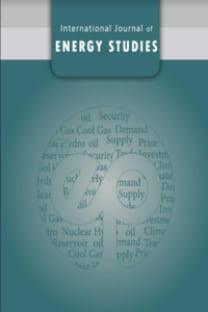Investigation of the three-phase heat pump drying system's impact on power quality of the electrical grid
Investigation of the three-phase heat pump drying system's impact on power quality of the electrical grid
Heat pump drying, Humidity and temperature control Energy quality, Harmonics, Reactive power,
___
- [1] Rahman MS, Perera CO, Thebaud C. Desorption isotherm and heat pump drying kinetics of peas. Food Res Int 1997;30:485–91.
- [2] Liu H, Yousaf K, Chen K, Fan R, Liu J, Soomro S. Design and thermal analysis of an air source heat pump dryer for food drying. Sustainability 2018;10:3216.
- [3] Prasertsan S, Saen-saby P. Heat pump drying of agricultural materials. Dry Technol 1998;16:235–50.
- [4] Strommen I, Kramer K. New applications of heat pumps in drying processes. Dry Technol 1994;12:889–901.
- [5] Zhan B, Wang Z, Shao S, Xu Z, Yang Y, Xu C. Simulation investigation on a novel open-loop air cycle heat pump drying system. Int J Refrig 2022;141:31–42.
- [6] Akmal M, Fox B, Morrow JD, Littler T. Impact of heat pump load on distribution networks. IET Gener Transm Distrib 2014;8:2065–73.
- [7] Navarro-Espinosa A, Mancarella P. Probabilistic modeling and assessment of the impact of electric heat pumps on low voltage distribution networks. Appl Energy 2014;127:249–66.
- [8] Kudelina K, Vaimann T, Rassõlkin A, Kallaste A, Huynh VK. Heat pump induction motor faults caused by soft starter topology — case study. 2021 IEEE 19th Int. Power Electron. Motion Control Conf. PEMC, IEEE; 2021, 454–9.
- [9] Aslan İ, Türkdoğan S. Bir kamu eğitim binasının enerji kalitesinin ve verimliliğinin analizi ile geliştirilmesine yönelik öneriler. Nat. Soc. Sci., Konya, Turkey, icensos 2023; 1: 643–51.
- [10] Tabak B, Yalçın MA. Elektrik güç sistemlerinde enerji kalitesi. Sak Univ J Sci 2004;8:52–4.
- [11] Sankaran C. Power Quality. CRC Press; 2017.
- [12] Fluke. Fluke 434/435 Three Phase Power Quality Analyzer 2008.
- [13] Dugan RC, McGranaghan MF, Santoso S, Beaty HW. Electrical Power Systems Quality. 3rd Edition. McGraw-Hill Education; 2012.
- [14] ABB. Technical Application Papers No.8 Power factor correction and harmonic filtering in electrical plants 2019.
- [15] Demirkol Ö. Harmoni̇k içeren ve dengesi̇z şebekelerde ölçme ve kompanzasyon. Master’s Thesis, Sakarya University, 2006.
- [16] Masetti C. Revision of European Standard EN 50160 on power quality: Reasons and solutions. Proc. 14th Int. Conf. Harmon. Qual. Power - ICHQP, IEEE; 2010; 1–7.
- [17] Ünlüsoy B. Enerji kalitesi, TS EN 50160 standardı ve ülkemizdeki uygulamaları. Schneider Elektr San ve Tic AŞ 2011;1.
- [18] Bhuvaneswari G, Charles S, Nair MG. Power quality studies on a soft-start for an induction motor. IEEEPES Transm. Distrib. Conf. Expo., IEEE; 2008; 1–6.
- Yayın Aralığı: Yılda 4 Sayı
- Başlangıç: 2016
- Yayıncı: Türkiye Enerji Stratejileri ve Politikaları Araştırma Merkezi (TESPAM)
Simulation study of bio-inspired leaf flow field designs for direct methanol fuel cell
Mikail YAĞIZ, Selahattin ÇELİK, Ahmed Emin KILIÇ
Energy and exergy analysis of the 1220 MW natural gas-fired Hamitabat combined cycle power plant
Sunay TÜRKDOĞAN, Mehmet DİREK, Cüneyt TUNÇKAL
Investigation of propane combustion at different equivalent ratios in a premixed model burner
Murat TAŞTAN, Kağan Cenk MIZRAK
Abdullah Emre AVCI, Mehmed Selim ÇÖGENLİ, Selahattin ÇELİK, Hasan ÖZCAN
Talha ERTÜRK, Ahmet ARSLAN, Erdal TUNÇER, Battal DOĞAN, Murat Kadir YEŞİLYURT
